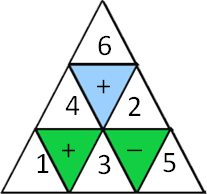Rules
-
$\begingroup$ Does each number occur once, or are we allowed to enter them multiple time? $\endgroup$– Mike LimburgCommented Apr 27, 2017 at 6:35
-
$\begingroup$ @MikeLimburg : each number occur once $\endgroup$– Jamal SenjayaCommented Apr 27, 2017 at 6:36
-
$\begingroup$ @JamalSenjaya , did you invent this problem or did you take it from somewhere ? If it is the latter then it would be nice to know of the source. Thanks $\endgroup$– Hemant AgarwalCommented Jan 13, 2021 at 1:36
-
1$\begingroup$ @HemantAgarwal I invented it, by a little programming If you want more like it, just browse my puzzles here at PSE. $\endgroup$– Jamal SenjayaCommented Jan 13, 2021 at 3:33
-
1$\begingroup$ @HemantAgarwal Oh, yes sure. Feel free to do that. You can also use my other puzzle to your youtube channel. $\endgroup$– Jamal SenjayaCommented Jan 16, 2021 at 6:17
2 Answers
Following a well-designed trail of clues leads to...
That trail begins at the two division / triangles
that both include the given 3
and must each include consecutive numbers.
The only possibilities are {2,3,6} and {3,4,12},
which fairly rapidly sift to:
• Use up 5 of the 7 available even numbers.
• Force a pattern of odd and even numbers among the remaining cells.
The 2 remaining even numbers fit only one way and:
• Daisy-chain upward to fill out all but the bottom row.
• Leave a set of numbers with only one pair that can
produce consecutive numbers in the bottom right triangle.
The bottom left corner shakes out from there. (And, yeah, the original path to solution involved some unnecessary trial and error.)
-
$\begingroup$ I hit the answer button, write the text "This is my solution", copy the picture from my local machine, then PSE says an answer was just added. I swear a lot, check the solution, is the same as what I found, swear again then upvote. Then swear again. Good job. ##@!#@(*&@# (censored) $\endgroup$– MariusCommented Apr 27, 2017 at 6:59
-
1$\begingroup$ OOOOOOOOOOooooo, Marius! You can be sure it has gone the other way, too, for both of us no doubt. $\endgroup$– humnCommented Apr 27, 2017 at 7:00
-
$\begingroup$ @humn : Still waiting for your logic explanation. $\endgroup$ Commented Apr 27, 2017 at 7:03
-
1$\begingroup$ Very funny, @Jamal Senjaya, another very well clued puzzle in any case, by the way $\endgroup$– humnCommented Apr 27, 2017 at 7:04
-
$\begingroup$ @humn : Thank you, I will try to create many more. $\endgroup$ Commented Apr 27, 2017 at 7:08
You actually get to the same solution with more work even if you don't read what green triangles mean.
That 3 you can see can be a part of (6, 2), (12, 4) and (15, 5) if you forget about green triangle rule. Due to subtraction below, 15, 5 cannot be on the bottom and (12,4) could be only if there is (14, 2) or (13, 1) below. Now if 12 is on the right, it would require +3 to make 15 = not possible, so 12 would need to be on the left. There is a plus sign too, so either 13 or 14 appears on the top and both 1 and 2 are used, meaning the other pair has to be (15, 5), and 11 is there on the right. Now, say there is 13 below - it needs 1 to make 12 and 9 to make 4 (14 would need 2 and 10). But to make 1 out of 2, or 2 out of 1, you need number 3, which is already used.
So, we have
6 and 2 are below 3. We have 3 options for the other division and that subtraction: (bottom towards top)
6, 2, 10; 3, 12; 4
6, 2, 13; 3, 15; 5
2, 6, 9; 3, 15; 5
Let's start with the last one:
6 cannot be made as 7-1, as you will not be able to use 7. (7+2 or 7-5 both duplicate a number). It cannot be made as 8-2, 9-3, 11-5, 12-6 obviously and 13-7 is eliminated for the same reason as 7-1. 10-4 has the problem of making 9 which would require 4+5. So, 14-8 is the only option. Bottom right is 1, then 8, then 14, then 12 - to make 2. We have 4, 7, 10, 11, 13 left. But we cannot make top right corner - no 2 numbers are 5 apart. OK, so this option is eliminated.
Next:
Let's consider 6, 2, 13 now. Under 2 we could have (7, 9) => 1, 7, 9, 4, (8, 10) => impossible, (9, 11) => impossible, (10, 12) => 4, 10, 12, 1 or (12, 14) => 8, 14, 12, 1.
Now:
First option leads to 8, 10, 11, 12, 14 for remaining numbers, which again doesn't have a gap of 5. Second one has 7, 8, 9, 11, 14. So, 14 on the top, 9 to the left of 5. We would need 12 to make that 9 and we don't have it. Too bad. And the third ends up with 4, 7, 9, 10, 11. 9 on top, 4 under it, 7 next. And now we require 1 which we don't have. So, this doesn't work either.
Finally:
We know the central part of the whole triangle is 6, 2, 10; 3, 12; 4. Now, how to make 10? (1, 9) is the only option. (2, 8), (3, 7) and (4, 6) are impossible. 9 needs to be right with 1 on the left or we won't make 2. Fill in 13, 7 to make 2 and 6. Note that remaining numbers are 5, 8, 11, 14, 15. To have difference of 4, 15 on top and 11 below are required. 14 to make 11, 8 to make 14 and 5 to make 8, and we have our unique solution.






